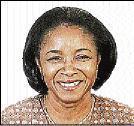Joyce Daley, Contributor
Nurse Joyce Daley
The early 19th century was ushered in with debates over the morbidity and mortality associated with anaesthesia in the United States of America. Surgeons decided that the major cause of the adverse effects of anaesthesia was the occasional 'anaesthetists', and called for clinicians to dedicate themselves solely to the speciality of anaesthesia. They began encouraging nurses to be trained as anaesthetists. Some of the reasons surgeons turned to nurses were:
(i) They would be satisfied with the subordinate role that the work required;
(ii) Make anaesthesia their absorbing interest;
(iii) They would accept the relatively low pay;
(iv) Nurses have the normal aptitude and intelligence to develop a high level of skill in providing the anaesthesia, the surgeon's demands among others.
Thus in the late 1800s, nurse anaesthesia was established as the first clinical nursing speciality in the USA. Today the American Association of Nurse Anaesthetists (AANA), in collaboration with the International Federation of Nurse Anaesthetists (IFNA) has set the gold standard for nurse anaesthesia worldwide. Notably, many of these nurse anaesthetists are struggling with the same pains of development that the USA nurse anaesthetists have confronted in their more than 100 years history. The nurse anaesthesia profession has strengthened and continues to grow through the dedicated members and outstanding leadership.
Nurse anaesthetists are registered nurse specialists, trained in the art and science of anaesthesia. They administer anaesthesia and related anaesthesia care to patients of all ages and for all types of surgical cases, utilising a variety of anaesthetic techniques. These highly skilled nurses monitor every important function of the patient's body, regulate the anaesthesia as necessary, analyse the patient's response, make decisions and respond quickly and appropriately in an emergency.
EARLY BEGINNINGS OF NURSE ANAESTHETIST IN JAMAICA
In Jamaica, nurse anaesthetists have been providing quality anaesthesia for over 50 years. They form the core of the anaesthesia services in the island's government hospitals, where they administer 65 per cent of all anaesthetics given each year and play a significant role in developing the practice of anaesthesia locally and in other Caribbean islands. The longevity of their practice can be attributed directly to their commitment to excellence and patient safety, and their willingness to provide service when and where needed.
Before the advent of nurse anaesthetists, anaesthesia was administered in rural hospitals during the early 1900s by dispensers, matrons of the hospitals or senior nurses designated by the medical officer/surgeon of the hospital. These dedicated persons had no formal training in anaesthesia, but were supervised by the surgeon who would administer the thiopentone and then return the patient to the nurse for monitoring. These nurses relied on their basic nursing knowledge, skills and their ability to nurse ill and unconscious patients. This system proved unsatisfactory for the surgical discipline as the safety of the patient was under constant threat. Surgical development was also hampered, as surgeons were reluctant to work in these rural hospitals. Most surgeons elected to do surgery under local anaesthesia. Many had the fellowship of the Royal College of Surgeons (London) and could do much more than was undertaken if better anaesthesia and postoperative care were provided. Many patients were forced to travel to the already overcrowded centres in Kingston for surgical intervention. In Kingston, anaesthesia was given by young aspiring surgeons, who themselves had little interest or no training in the speciality.
Nurse Anaesthetists Training in the USA
Dr Leo Freeman, senior medical officer at Spanish Town Hospital, on one of his visits to the USA in the 1950s observed nurse anaesthetists trained in the art of anaesthesia, competently administering general anaesthesia. On his return to Jamaica, he lobbied the Government to send nurses for training in the USA. However, before negotiations were completed, Nurielda Ernandez Newman, a theatre nurse at Spanish Town Hospital, paid her fare and tuition fee to pursue training in nurse anaesthesia at the Graduate Hospital of the University of Pennsylvania. She returned in 1957 to work at Spanish Town Hospital.
Improvement in Care And surgical Procedures
Newman, on her return to the Spanish Town Hospital, performed creditably and so improved patient safety. Surgical load increased immensely. The Ministry of Health was impressed by her performance, and this paved the way for a total of 11 registered nurses to be sent to Pennsylvania for training from 1958-1962. Some of those trained were Ivy Jarrett-Brown, Dorothy Denny, Sylvia Warren, Hyacinth Brennan, Lesmin Smalling, Daphne Bloomfield, Lodi-Faye James, Nellie Seivwright, Ruth Gyles, Hyacinth Brown and Hyacinth Clarke.
Nurse anaesthetists have been sole providers of anaesthesia in rural hospitals up to the present time. Hospitals served include Falmouth, Cornwall Regional, Lionel Town, Princess Margaret, Mandeville, Savanna-la-Mar, St Ann's Bay, Alexandria, Port Maria, Port Antonio, Annotto Bay, Black River and Percy Junor.
Today, nurses are at the forefront of the anaesthesia services in the public hospitals. Not withstanding the many challenges of their role in the health-care team, over-enthusiastic surgeons, equipment failure, long and tiring hours of work and inadequate remuneration and recognition for work well done, these nurses continue to respond with dedication and commitment to their patients, employees and colleagues.

The birth of anaesthesia: Sister Smalling anaesthetising a patient at the Spanish Town Hospital.

